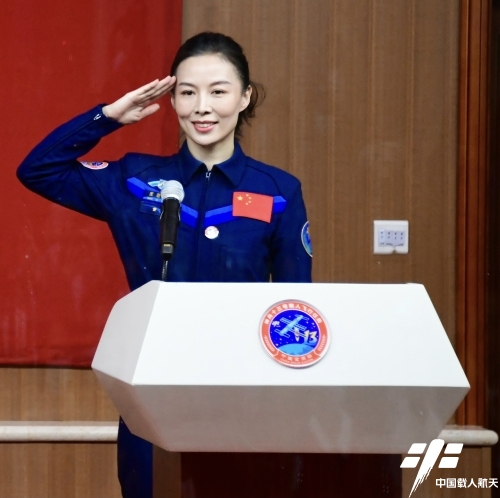China's Shenzhou 13 crew takes its first spacewalk, the country's 1st by a female astronaut

The Shenzhou 13 astronauts aboard the Chinese space station took the first spacewalk of their mission Sunday (Nov. 7), marking the country's first spacewalk by a female astronaut.
The three Shenzhou 13 crewmembers— commander Zhai Zhigang, Wang Yaping and Ye Guangfu — arrived at the Tianhe space station module hours after launch on Oct. 15. The China Manned Space Agency announced plans for the spacewalk in a statement (Chinese) on Friday (Nov. 5). At the time, the agency did not provide information on the precise timing or objectives of the spacewalk, nor which crewmembers would embark on the extravehicular activity.
On Sunday, CMSA announced that the spacewalk was underway and it was being performed by astonauts Zhai Zhifang, the Shenzhou 13 mission commander, and Wang Yaping, the country's second female astronaut to fly in space. Wang is now China's first female spacewalker. Their spacewalk was expected to last six hours.
Related: The latest news about China's space program
Wang Yaping became China's second woman in space in 2013 aboard the Shenzhou 10 mission. Zhai, meanwhile, became the first Chinese astronaut ever to perform a spacewalk during the Shenzhou 7 mission in 2008.
Clues that Wang would perform the spacewalk appeared last week in CCTV interviews by Chinese space officials.
"The Shenzhou 13 astronauts have finished their settling-in settings. And they have unpacked the new extravehicular suit we just sent up with the Tianzhou 3 cargo spacecraft and completed various tests to make sure the space suit is well set for extravehicular activities," Wu Hao, an assistant researcher of the China Astronaut Research and Training Center, told CCTV.
Breaking space news, the latest updates on rocket launches, skywatching events and more!
Two suits were sent aboard Tianzhou 2 to support Shenzhou 12 spacewalks, but the additional suit suggested it could be one specifically for Wang.
Two to three extravehicular activities are planned for the six-month-long Shenzhou 13 mission, according to a pre-launch press conference at the Jiuquan Satellite Launch Center. Major objectives were stated to include installing an adaptor to allow Tianhe's large arm to connect to another, smaller arm that will be on a future module.
The Shenzhou 13 crew have been during their three weeks in orbit. The mission is planned to last twice as long as the three-month-long Shenzhou 12, China’s previous longest mission.
During this time the astronauts have successfully transferred supplies from the Tianzhou cargo spacecraft docked with Tianhe, including carrying out maintenance, performing daily exercises to counter the effects of microgravity and conducting medical examinations and scientific experiments, the CMSA statement noted.
Wang Yaping and Ye Guangfu, making his first trip to space, also tested the microbial content of water aboard Tianhe, footage released this week revealed.
The crew also prepared for and drilled for emergency operations including evacuation and first aid. Meanwhile on the ground at Jiuquan Satellite Launch Center, a Long March 2F rocket and the Shenzhou 14 spacecraft are in a state of near-readiness in the case of an emergency in orbit.
Follow us on Twitter @Spacedotcom or Facebook

Andrew is a freelance space journalist with a focus on reporting on China's rapidly growing space sector. He began writing for Space.com in 2019 and writes for SpaceNews, IEEE Spectrum, National Geographic, Sky & Telescope, New Scientist and others. Andrew first caught the space bug when, as a youngster, he saw Voyager images of other worlds in our solar system for the first time. Away from space, Andrew enjoys trail running in the forests of Finland. You can follow him on Twitter @AJ_FI.

